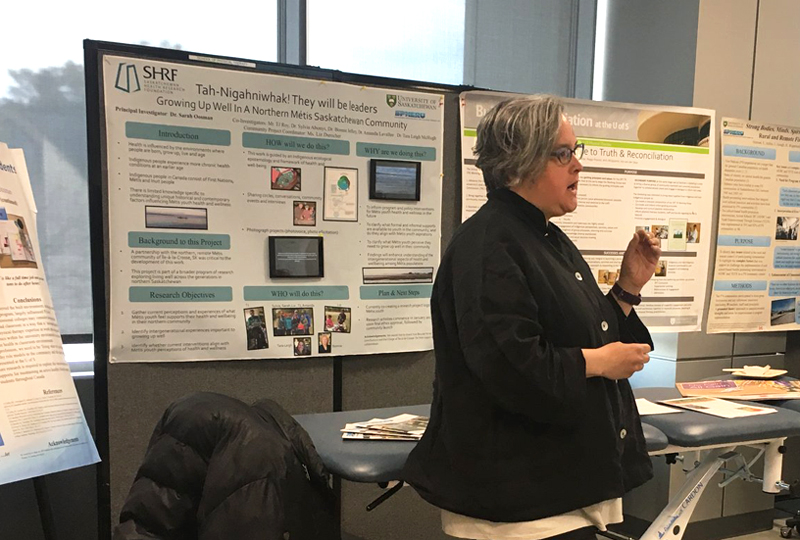
Rehabilitation research is on the move
Exciting research is being conducted in the School of Rehabilitation Science, with an emphasis on interdisciplinary work
By Amanda WoroniukRehabilitation science is considered one of the fastest growing fields to support health, quality of life and well-being. In the recently renamed School of Rehabilitation Science, faculty and researchers are committed to improving health and the healthcare system through innovative research activities.
The range of these endeavors was shared at the school’s research day, where each of the 11 faculty members presented their current research to a group that included colleagues in other health professions, faculty and students.
“The event demonstrated current strengths and emerging research potential in the school,” said Dr. Liz Harrison, associate dean of the school. “Faculty members and their trainees (including doctoral students) talked about the focus of their research, their collaborative research teams and how research is leading to change in health care practice and policy. “
In addition to the presentations, there was an interactive element – short demonstrations with pieces of research equipment – followed by a brief poster session.
“It was a great learning experience for our own faculty to hear what each of us are working on. It’s not often you have the opportunity to hear what your colleagues are doing.”
She noted that that the school’s research spans different areas of rehabilitation science, with a common thread of health, quality of life and how it relates to function and participation in society.
“Currently our rehab science faculty are primarily physical therapy researchers but they work with a range of patient populations, health professionals, interventions, and communities,” explained Harrison.
For Harrison and her colleagues, an interdisciplinary approach to their work is critical. “You can’t solve complex problems without a team approach. We all participate as members of teams exploring issues that often span bench to community research.”
As examples, Harrison pointed to research collaboration with colleagues in other disciplines including medicine, public health, engineering, economics, pharmacy, nutrition, kinesiology and nursing. She also highlighted the significant advances over the years in partnerships with rehabilitation researchers across the globe.
Some of the school’s current research includes:
Dr. Stephanie Madill, who is investigating links between osteoporosis and urinary incontinence in older women using proteomics. As part of Madill’s research, she created an internally inserted device that is the first to allow pelvic floor function assessment and measurement during movement.
Graduate student Angelica Lang’s research is focused on shoulder dysfunction in breast cancer survivors following treatment.
“Many breast cancer survivors experience upper limb problems after treatment,” said Lang. “But it’s not yet known how this affects shoulder movement, which can increase their likelihood of future injury.”
The purpose of Lange’s project is to define the shoulder motion of breast cancer survivors while completing a range of functional tasks. She hopes to determine how their ability to perform daily work and life tasks is affected by treatment, and how any changes in motion could be linked to further shoulder injuries.
Like other faculty in the school, Dr. Brenna Bath is involved in several different areas of research, which includes a focus on prevention and management of musculoskeletal conditions; investigation of differences in health and health care needs among vulnerable populations; and the use of teams and technology to help those in rural and remote communities access physiotherapy services. She works with colleagues in the school, the Canadian Centre for Health and Safety in Agriculture, and a range of community partners and stakeholders.
Graduate student Liris Smith’s research is focused on community-based Indigenous health. She spends time in Île-à-la-Crosse, a northern Saskatchewan village that identified the importance of activity in older adults. In partnership with the community, Smith is working with Drs. Sarah Oosman and Sylvia Abonyi on healthy aging. Her research hopes to reveal the physical activity experience through the eyes of older Métis adults.
“This is a community-based participatory action research project. Physical activity was identified by the community as one of their priorities for healthy aging,” said Smith. She noted that the research on physical activity in Métis communities is limited (and sometimes conflicting). Smith is hopeful that this research will help reveal the Indigenous context of physical activity and offer insights that could be used to inform healthy aging interventions.
For Harrison, the school’s variety of research, along with advancements in rehabilitation science will ultimately have a positive impact on health outcomes in the province.
“We are able to span different communities from basics to application.”
